#Buddhist Strategies
Explore tagged Tumblr posts
Video
youtube
Finding Silence in Noise: Buddhist Strategies for Coping with Stress
#youtube#mindfulnessmatters#Buddhist#Buddhist Strategies#stressrelief#buddhist wisdom#mindfulliving#mindfulness
1 note
·
View note
Text
I wasn't obsessed with The Ex-Morning to start, but I trusted it would hit me eventually. You see, the thing I love about Lit Phadung as a director is that he never tries to be above the classic Thai BL aesthetics. The production hallmarks are all there: dialogue-heavy stories with generic comedic scoring and stable cameras theatrically focusing on people rather than any dynamic or poetic cinematography. He chooses works that bring broad, obvious characters to life for us. The work of his I've seen--the full SOTUS series, Love Mechanics, Love in Translation, and currently The Ex-Morning--is remarkably unpretentious, always skirting the line of cheesy. This all sounds hardly complimentary. And yet. And yet!
A few episodes in, his series begin to unobtrusively swell like a tide moving in with the density of the characters and thematic subtext. Episode 6 in SOTUS S inspired me to research and write a whole 20 page essay on the 4 Act structure. Episode 3's where The Ex-Morning hooked me. An example of a master at work in episode 3, we get the shipping-moment where Tam grabs Phi's hand, a perfect example of how Lit layers quiet symbols amongst the cheese of romance. The narrative set-up here gives us classic BL. Blatant skinship edited and closely framed to make it impossible to miss or misread its romantic implication. We even have a fujoshi observer to remind us the gaze we're meant to use.

fighting certain urges about the hair on Singto's hands
But P'Lit and screenwriter Aof--who I've argued appears to have adapted these techniques from P'Lit's work on SOTUS--layer this shot with other visual information. In zooming to the hands, the ring, the mala bracelet, and the act of writing get secretly highlighted amongst the yaoi content. The show has not pushed us hard to think about their meaning yet, but there's been a subtle focus on jewelry and accessorizing already and the Buddhist themes have been an emerging question, too. It's just one of many examples in the series where the questions of materialism, emotional attachments, authorship, and queer embellishments arise without hammering the audience over the head with it.
And then on top of these visual strategies, Lit consistently draws out overwhelming performances from his actors that imbue what might otherwise be camp with a raw humanism, heightening the stories beyond run-of-the-mill romcom plots. With their flawed, conflicted characters and unflinching portrayals, they're tests of empathy.

It's no surprise he's launched the careers of several renowned pairs--Kristsingto, DaouOffroad, YinWar (not their first outing, but the one that elevated them past their peers). In a P'Lit world you get to play a full range of emotions, and he's not interested in requiring violence or high-concept plots to experience those feels. It's pure romcom, with the full breadth of its possibility, which is something I adore.
Lit's not an auteur by the traditional definition. His vision's not singular, his work not so marked by his idiosyncrasies to be easily chosen out of a lineup of his peers. I think it's better for that. He intricately crafts his works so that you don't have your attention drawn to its craft or intricacy, letting the story and characters, which at first might seem silly, take hold of your soul.
81 notes
·
View notes
Note
Do you have a favourite c-drama, either historical, modern or fantasy? I really enjoyed watching Everlasting Longing
I absolutely have a favourite, along with 3 other that come really close 😃 These 4 shows I've watched for almost 30 years now and I still keep re-watching them because of how amazing they are.
a) 1994 Romance of the Three Kingdoms (三国演义) b) 1986 Journey to the West (西游记) c) 1987 Dream of the Red Chamber (红楼梦) d) 1998 Water Margins (水浒传)
These 4 series were based off of the classical novels of the same names. They were produced by CCTV, the central broadcasting network in China, so we call them 央视版 (central broadcast version) because there are many other adaptations.

Romance of the Three Kingdoms, out of these 4 series this one is my ABSOLUTE favourite. Not only for Chinese drama, this is my favourite show historical, modern, Chinese, English, the top spot in my heart.
This story is set in the Three Kingdoms period of Chinese history. Out of all 4 classics, this one is the most historical, but the story DOES contain many fictional aspects. Many people say it's 70/30 (70% based on history, 30% made up/tweaked from history). The characters themselves ARE all real in history, and the general direction of the story follows history as well.
Near the end of the Han Dynasty, local warlords started gaining power, eventually splitting the country into 3 Kingdoms. That's pretty much the basis of the story. It goes into strategies used in warfare, psychology of using strategies, famous battles, etc. People also use it to discuss some philosophical questions like, honor, right vs wrong (kill an innocent person to calm an entire army, is that justified? etc.), what is acceptable as a leader, being faithful to your country, not giving up, etc.
I've watched this series no less than 20 times over the past 30 years and every time I still laugh and cry. I also know enough about the background when they were filming to know how difficult it was. The series is 84 eps long, they filmed in 5 groups for 3 years (so basically all 5 groups were filming at the same time to save time), even utilizing the military for some of the larger battles. Main character roles were paid 250 yuan/episode (about $34 USD today), which was fairly good for salary back then but nowhere near the outrageous amounts actors get today compared to average worker. The first few months before filming all actors went through training, horseback riding, fighting, going over the novel with experts, learning etiquette and mannerisms, etc.
This series also has my favourite historical figures, Emperor Liubei and his Prime Minister Zhuge Liang. After researching the actual history of this period, these two are my top historical Emperor/advisor pair. An Emperor who trusted his Prime Minister with his Kingdom, and a Prime Minister who fought to the last breath to fulfill the dream they had together T___T 为什么我的鱼水君臣要 BE...😭😭😭
If you're interested in watching this series, @hanchaozhilang is doing English subs for the whole series
Putting up 2 MVs for them here (combined into 1 video), 我家昭烈帝和武侯有排面!!
Srcs: 一知半解书 【悬溺一响,诸葛亮登场】 https://www.bilibili.com/video/BV1nP411W7tA/
博文儿吖 【刘备|正史燃向】翻译翻译什么叫昭烈! https://www.bilibili.com/video/BV14r4y1m7rs/
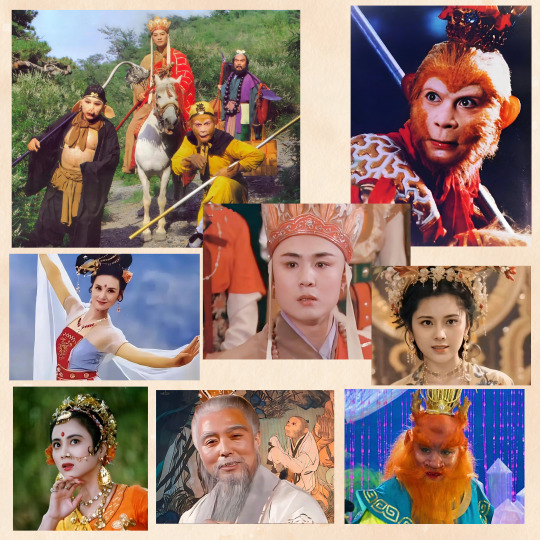
Journey to the West is based off of a true event in history, during the Tang Dynasty. A monk went on a journey from Chang'an (now Xi'an) to India for Buddhist scriptures. I'm not too familiar with the actual history, but I can imagine back then it would've been an incredibly difficult journey to make.
The novel took that journey and expanded it. They wrote in 3 disciples for the monk (technically 4...the horse who's the son of one of the Dragon Kings is also one), and put 81 "tests" along the way. The monk and his disciples had to overcome these attempts to thwart their journey to finally reach their goal.
The main character of this series isn't actually the monk but his eldest disciple, the Monkey King (top right). The Monkey King (named Sun Wukong) was birthed from a rock, and learned skills like how to transform into various objects, how to fly, etc. At one point he trashed the Jade Emperor (Emperor of the Heavens) palace and was sentenced by Buddha to be trapped under a mountain, but was tasked to assist the monk on his journey 500 years later.
When they filmed this series they were desperately short on funding, only had 1 video camera to use xD Every single main actor took on several roles (some of the smaller monster roles, once all the makeup was on you couldn't tell anyway). The actor who played the Monkey King, Liu Xiao Ling Tong, he came from a family of Peking Opera performers who specialized in the Monkey King role, so he excelled in it.

The novel Dream of the Red Chamber is originally called Story of the Stone (石头记). It centres around several large, rich, powerful families interconnected through marriage, with members serving in the court and one of the daughters even being a concubine to the Emperor. Although the story doesn't specify a dynasty, most people speculate it's likely set in Ming (the author was from the Qing Dynasty).
There are numerous storylines throughout the story, but the main one is between a young man, Baoyu, and his cousin, Daiyu (top left). This novel is incredibly complicated, with an entire profession dedicated to studying just this book (called "Redology" 红学). It can be viewed as telling the rise and fall of a family, but can also be viewed to describe a society and the rise and fall of dynasties. There are many, many characters in this book all with different story arcs. When I was a child, watching this show was just pretty clothes and hair, but as I grew, every time I re-watched the show I found reflections of life in this story. Family relationships, friendships, colleagues, bosses, this story touches on all of them, so whatever age you read this book/watch this show there's things to think about.
Many of the actors for this show were not actors by profession, literally plucked from the crowd. For two years prior to filming, all of them lived together, learning the script, reading the novel, going over it with experts, learning mannerisms, how to write calligraphy, poetry, etc. Their roles weren't immediately set, so during those two years they all tried out different roles, memorized lines, basically like living in a giant dormitory together, so once filming did start their "acting" was very natural.

Water Margins is set in the Song Dynasty. This story, to me, is darker than the other 3. The story depicts a court that is very corrupt and unjust, which forces a lot of otherwise good people to resort to criminal activity. Over 100 of them gather on a mountain in the middle of a lake, called Liangshan, where they essentially become a gang.
The traditional view of them tended to be kind of like Robinhood, raiding local cities and distributing the wealth to the people but if you actually read the book it's darker. Before joining the group, some of them would kidnap women and **** them, or one person had a restaurant where she murdered customers and made them into meat buns O.O;; So...yeah, dark stuff.
But anyway, the story goes into how this group take on the courts, lots of fighting, lots of bloodshed, the ending's really tragic T_T
#中国#china#chinese history#c-dramas#dream of the red chamber#journey to the west#romance of the three kingdoms#water margins#电视��#古装电视剧#三国演义#西游记#红楼梦#水浒传#央视#央三#86西游#87红楼#98水浒#怀念老剧#前几天看到丞相在B站拜年开心哈哈
145 notes
·
View notes
Text
Well, I did say this was a multi-fandom blog... Alright, let's do this.
The Qing Jing Peak Lord's Bamboo House
(and the symbolism therein, as recorded in the donghua)
I was snooping through the establishing shots of the Qing Jing Peak Lord's Bamboo House, and had to laugh as I always do at all the gay symbolism that managed to sneak its way inside. But then I looked a little closer, and was floored by just how much passive storytelling was packed into background assets. I talked about it at length over discord, and at the urging of others decided to make a shareable post on social media as well.
First, the shots which first piqued my interest in this topic years ago:
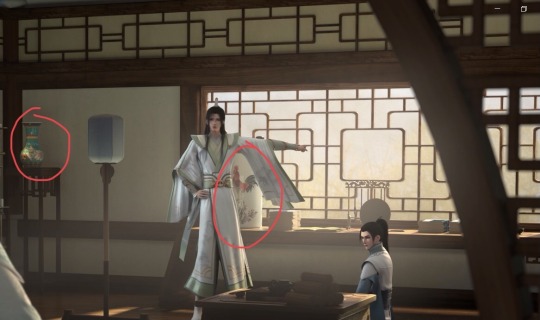
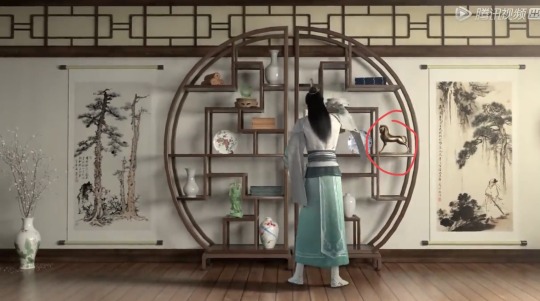
Shen Yuan transmigrates into the stallion-genre webnovel entitled 狂傲仙魔途 (translated as Proud Immortal Demon Way). The author's and his own usernames are dick jokes.
Notice the chrysanthemum vase, the cock vase, and the stallion statuette.
The stallion and cock are obvious nods to these jokes on their own, but for the uninitiated, the chrysanthemum is a symbol of gay sex between men, as the asshole itself is often euphemistically referred to as a chrysanthemum. This should have been Shen Yuan's first clue that not all is as it seems here! These are the personal quarters of Shen Jiu — the original Shen Qingqiu!
But let's move to the main room you first walk into upon entering the bamboo house.
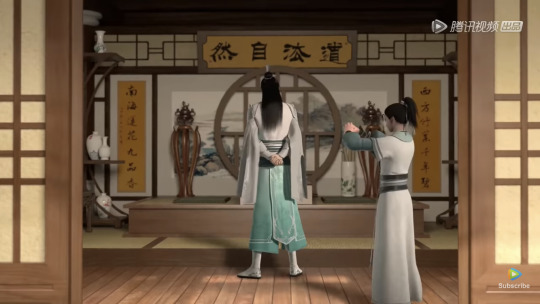
There it is: the writing on the wall.
As the Peak Lord of strategy and the scholarly arts, Shen Qingqiu would naturally have calligraphy and paintings hanging everywhere! So let's break it down.
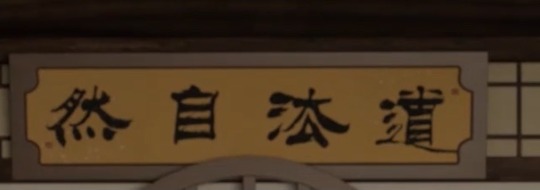
On the top we have 道㳒自然 ("Dao Follows Nature"), which comes from a Dao teaching by Laozi (founder of Daoism) meaning that life, death, the entire universe, the heavens and earth and everything outside and inbetween, all follow a set of laws referred to as the nature of things. Although unrelated to the Buddhist couplet below, it's certainly relevant!
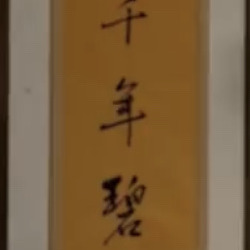
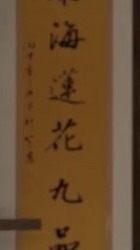
Originally hanging in right-to-left order, I've arranged them to read left to right here to make things easier to keep track of. The calligraphy reads 西方竹葉千年翠;南海蓮九品香 and is a couplet commonly found in Guanyin temples. My classical chinese is not as strong as I'd like, but this translates roughly to "The bamboo leaves in Paradise are green for a thousand years / The fragrance of lotus flowers in the South China Sea is as thick as 9 sticks of incense."
The character 西 for West is used to denote the destination of enlightenment/purity: the buddhist Paradise (think Journey to the West). The South China Sea is where Guanyin was born. Upon the Lotus flowers is where Guanyin is commonly depicted as sitting. The "9 sticks of incense" though literal can also refer to the 9 tiers/grades of reincarnation lotuses with the 9th tier being the lowest, meant for those who in life committed the most evil of crimes — the 4 parajikas — and who can only manage a sincere Amitabha recitation 10 times and no more than this.
To put this in context with Shen Jiu (the same jiu as in 9/九), the 4 parajikas committed by the 9th Tier Lotuses Reborn (officially entitled the Lowest of the Low) are:
Sexual Intercourse
Stealing
Murder
Claiming attainments of stages of pure mental concentration that have not been achieved (in other words, rushing or lying about your cultivation/enlightenment, or maybe even becoming a Peak Lord without having formed a golden core beforehand).
From what we know in the context of the novel, Shen Jiu is innocent of at least the first of this parajikas, but the overall view of Shen Jiu in the eyes of others in the story is that he is guilty of them all. This calligraphy can be seen as a condemnation or a reminder for the character Shen Jiu, who even as the Peak Lord Shen Qingqiu is widely thought of as a scum villain and the lowest of the low.
Phew! That's a lot to unpack.
But if you turn your gaze to the original screenshot, you'll see to the right that there's a vase painted with a blue bird. This vase appears in several rooms of the bamboo house, and seems to be the image of a qingniao (青鸟; lit: Qing bird, wherein 青 can mean blue/green/clear-but-brackish black).


These qing-coloured birds are messengers and foragers of the Goddess-Mother of Paradise (Xiwang-mu 西王母, the "west/paradise" character from before, lit West-King(unisex)-Mother). They're a highly intelligent species who are exceptional in song (a good representative for Qing Jing's scholarly arts and pursuit of qin!), and the older ones might learn to speak human tongue. As a subspecies of luanniao (鸾鸟 lit: luan bird), they're thought to be related to The Phoenix and indeed thought to be the lifetime/samsara just before being reborn as a Phoenix.
If given to a "master" they don't like, the qingniao may refuse to pass messages or sing until they're set free, but if they do get along with you then they're loyal to the end.
As a point of interest, the Qing generation of Peak Lords uses the character 清, which is 青 ("colour of nature; brackish black, blue, green; young) + the radical for "water," resulting in the meaning of clear (as in water or heart; see-through); distinct; quiet (as in still); just and honest; pure; to settle or clear up; to clean up, expunge, or purge.
And as a bit of trivia, Liu Qingge's sword Cheng Luan 乘鸾 means "to ride the luan, take flight on the back of a luan." (Relevant, because the qingniao is considered a subspecies of luanniao).
With the Lords of both Qing Jing and Bai Zhan referencing this bird, I really wonder about its significance! It's spawning plenty of theories and headcanons for me.
Heading back outside for a moment, you'll find that in the Quiet Pool (清静小池 qingjing xiaochi (yes, the same Qing Jing the peak is named for)), there are lotuses, and on land there are flower shrubs which are either wide-petaled chrysanthemums (gay bottom jokes ahoy), or a type of peony, the king of flowers demarcating wealth and prosperity. Either way, a blossom fitting of our Qing Jing Peak Lord Shen Qingqiu!

My one regret is that I cannot get a clear shot of the fan hanging on the wall to try and translate the calligraphy on it. If anyone can snag one, please tag me! I also couldn't translate the paintings with poems hanging in Shen Qingqiu's bedroom (it's just too small and blurry for my bad eyes to make out). If I make another post attempting these things, I'll append them to this initial post in an edit afterwards.
#svsss#shen qingqiu#liu qingge#i started writing this at 3am#and now it's 8am#what am i doing with my life#who have i become#qing jing peak
653 notes
·
View notes
Text
A new perspective on Hakurei Myōjin
Abstract: the poorly documented deity Hakurei Myōjin (博麗明神) has received little attention from scholars of Japanese religions. The accepted attestations are limited to a handful of setsuwa and a poorly preserved Muromachi period illustrated scroll conventionally referred to as Hakurei Engi Emaki (博麗縁起). These works are often presumed to be satirical, as they portray the deity as an exterminator of supernatural threats whose shrine is nonetheless visited mostly by oni and other similar beings. In absence of other evidence, the name was presumed to designate a purely literary creation, comparable to Henge Daimyōjin (変化大明神) from the more famous Tsukumogami Ki (付喪神記). However, recent inquiries into archives of a number of Buddhist temples indicate that a new approach to the study of Hakurei Myōjin is necessary. While much still remains unclear, it is now evident that not only Hakurei Myōjin was an object of active worship through the middle ages and possibly beyond, the theological ideas propagated by ritual specialists attached to his shrine, the location of which is still not entirely certain, were at various points in time supported or contested by more powerful religious institutions.
In this article, Ifocus on a recently discovered set of texts documenting a lawsuit against the Hakurei shrine. While precise dating is not yet possible, it can be argue that a terminus post quem can be established based on references to the theological concept of reverse honji suijaku, which flourished in the late middle ages. Additionally, the lawsuit offers a close parallel to the conflict between Ise and Mt. Asama revolving around the identification of the local protective deity, Uhō Dōji (雨宝童子), with figures associated with a variety of well established temples and shrines, especially Ise’s Amaterasu. While it is presently not possible to evaluate the validity of accusations apparently leveled at a particularly industrious anonymous Hakurei shrine maiden, it is possible that similar strategies as at Mt. Asama were indeed employed in a bid to make the shrine attractive to pilgrims and to increase the prestige of the deity. I also propose a number of possible explanations behind the identification of Hakurei Myōjin with the deities of Ise, Mt. Miwa and in particular Mt. Hiei.
I came up with this joke on the 6th of April last year, it spent an entire year in the drafts awaiting this day. My self restraint is truly astonishing.
60 notes
·
View notes
Text
Hot post-Silverstone thoughts:
Ehhhh… WHAT was that race???
Absolutely chaotic.
Ferrari? I don’t even know who thought starting on mediums was a good idea. Charles would’ve needed luck for that to work and when has Charles ever had luck?
His whole weekend felt like a horror movie: starts off great, ends with people being mauled by werewolves in the woods.
Honestly wouldn’t be surprised if he’s currently considering retiring to a Buddhist temple in Tibet.
Mercedes? Meh. Could’ve done better. That late gamble was a bit too much.
Max somehow managed to patch things up by the end... classic damage control mode activated.
Lewis was solid, and honestly proved that with a normal strategy, things could’ve looked very different.
Oscar… yeah, turns out he’s not made of ice either.
Lando winning? Oh boy. Things are about to get spicy at McLaren. I want front-row seats to the incoming Papaya War™.
And honestly, the one real highlight of the day: HULKENBERG.
So, so happy for him.
Other than that… see you in Spa.
I’m going back to writing my fic and pretending this entire season isn’t happening. 🫠✍️
#charles leclerc#max verstappen#f1#ferrari#silverstone 2025#papaya war#incredible hulk#nico hulkenberg#lestappen#fanfic#ao3
28 notes
·
View notes
Text

You Don’t Have to Be Nice: Avoiding Idiot Compassion
“Buddhists are supposed to be nice.” How many times have I heard that one? Buddhists are stereotyped as always being pleasant, soft-spoken and calm, and we aren’t always.
Of course, the Buddha taught the cultivation of loving kindness and compassion. The practice of Right Speech requires abstaining from rude and abusive language. Isn’t that the same thing as being nice?
Maybe not. Many Buddhist teachers have said that being compassionate and being “nice” are two different things. Most of the time, “nice” is mere social convention. It says nothing at all about relating to other people except on a superficial level. Even sociopaths can be nice (I have seen this with my own eyes). Sometimes the guy who is yelling and throwing furniture around is the one who cares.
Idiot Compassion
“Idiot compassion” is a term attributed to the late Chogyam Trungpa Rinpoche, although he may have borrowed it from the Russian spiritual teacher George Gurdjieff. Idiot compassion can take several forms.
The Rinpoche related it to “doing good” as an act of self-gratification.
“Idiot compassion is the highly conceptualized idea that you want to do good to somebody. At this point, good is purely related with pleasure. Idiot compassion also stems from not have enough courage to say no.”
Trungpa’s student Pema Chodron elaborated,
“It refers to something we all do a lot of and call it compassion. In some ways, it’s whats called enabling. It’s the general tendency to give people what they want because you can’t bear to see them suffering. Basically, you’re not giving them what they need. You’re trying to get away from your feeling of I can’t bear to see them suffering. In other words, you’re doing it for yourself. You’re not really doing it for them.”
“Nice” is often a strategy to avoid conflict. But isn’t avoiding conflict a good thing? Not always; there are times when engaging in conflict is compassion. Sometimes the urge to be “nice” is about maintaining a polite and pleasant facade over a situation we don’t want to confront.
There is a difference between “judgmental-ism” that tears other people down to build ourselves up, and making a qualitative judgment about a situation or behavior. If “Right Speech” means we’re supposed to stand by smiling while someone kicks a dog or endangers a child, you can have it. Fortunately, that isn’t what it means.
However, a lot of us are well conditioned to keep our noses out of other peoples’ activities, and it can be really uncomfortable to speak up. It’s so much easier to shrug things off, avert your eyes, and tell yourself you are not being judgmental.
But those are the times when you really aren’t being judgmental, because it’s not your ego telling you to speak up. If your guts are telling you something needs to be addressed, but you fear doing so because of how other people will react to you, then it’s your ego telling you to stay quiet. If you know something is wrong but have to club your way through an internal wall of conditioning and fear of social censure to speak up, very probably you really need to speak up. And other people need you to speak up, too.
Another example of idiot compassion is responding inappropriately out of ignorance of a situation. For example, after major catastrophes such as tsunamis or hurricanes people naturally want to help. Relief organizations say the help often makes things worse, however. Well-meaning people send cans of food from their cupboards and leftover shoes and clothes from their closets, and aid workers say sorting and distributing these things is a nightmare and a drain on their own resources. Plus, often what is sent isn’t really what is needed. If you want to help it’s almost always better to find a charity or relief organization you trust and send some money.
Smart Compassion
Genuine compassion is rooted in wisdom. Wisdom in the Buddhist sense is about not clinging to what makes us feel good about ourselves or doing what we think will make people like us. Rather, it is perceiving a situation as-it-is without our own self-interest getting in the way. Wisdom helps us respond appropriately and with a clear mind to a difficult situation.
But now let us wade into day-to-day social situations, which is where most of us are likely to trip up. You find yourself discussing a political or social issue with someone whose opinions you find genuinely heinous. Do you tell him so?
Thich Nhat Hanh provides us of an example of someone who has spoken out on difficult issues without breaking his vows. When he first came West it was to speak out against the U.S. war in Vietnam. He often faced angry people telling him he was wrong, yet he managed to not lose his composure and respond with anger. This venerated teacher advocates mindfulness training to guide our actions. Reminding ourselves that the person we’re talking to is a real human being and not just a gasbag with an opinion helps, too. But responding with compassion to hateful views doesn’t mean we can’t voice firm disagreement.
…🙏
34 notes
·
View notes
Text
Ping Jinchuan: A 19th century Sci-fi Shenmo Novel
Like all popular novels, when something sets a trend, many imitators follow suit, until the formula becomes its own genre of sorts.
FSYY is one such genre setter. Specifically, the "Battle of Arts" (斗法) formula, where immortals and deities are added into a historical event——usually a war, but it can also be something like Admiral Zheng He's voyage——and proceed to use said setting as an excuse to battle it out using spells, magical treasures, and formations.
It's such an enduring formula, late Qing novels were still following it. And because it's the 19th century, western technology and ideas were entering China and making their way into popular culture.
My first exposure to the results comes from Legends of the Eight Immortal Attaining the Dao (八仙得道传), where the narrator occasionally interrupts the story and goes: "Electricity-based technology is totally the work of Mother Lightning, guys!"
Why am I telling you all these random facts? Because Ping Jinchuan ("Quelling the Golden Stream") is that, but turned up to eleven.
Technically, FSYY is set in Shang dynasty China. Technically, Ping Jinchuan is an obscure 1899 novel about the quelling of rebellions in Qinghai and Tibet during the 18th century by the historical general Nian Gengyao.
However, considering that FSYY has 11th century BCE gunpowder weapons, and...the entirety of Ping Jinchuan, I really doubt the claim of the latter novel's author that the story is based on the eye witness accounts of his ancestor, who worked as an advisor under Nian Gengyao.
But if you insist, here's a rough summary of the historical background: the first war Nian fought in Tibet happened during the reign of Kangxi, because the Dzungar Khanate invaded Tibet.
The second rebellion Nian quelled in Qinghai, during the reign of Yongzheng, was started by Lobzang Tendzin. He fought against the Dzungar Khanate with the help of Qing army, but rebelled together with local chiefdoms and Mongol leaders when he was not granted the rulership of Tibet afterwards.
(Confusingly enough, during the reign of Qianlong, there were also 2 other rebellions by the chieftains of "Greater and Lesser Jinchuan" in northwestern Sichuan, which might be where the novel's name came from.)
Naturally, the novel proceeds to tell a "Battle of Arts" story, about Tibetan Buddhist monks, Muslims, Daoist sages, and the leaders of the Roman Catholic Church duking it out with typical Shenmo novel treasures...and 19th century magitek.
There is potential for some serious analysis about Qing military expansion, violence on the frontiers, how foreign religions and people are perceived through the framework of popular fiction, etc. But honestly, after seeing the above summary, are you really here for *that*?
I'm not, because I don't know nearly enough about the historical context, and the entire premise is ridiculous enough to defy any attempt at taking it seriously——unless the attempts are ironic.
Case In Point
The novel starts off pretty tame: Lobzang Tendzin, "King of Jinchuan", wanted to send his own Dalai Lama candidate to Tibet after the previous Dalai's death, as part of a power ploy to make himself the de facto ruler of Tibet.
He allied himself with Galdan, the Dzungar ruler, to force the Tibetans to accept his candidate at gunpoint——literally.
Their firearms and cannons got stopped by a Lama named Ding Chan, who used his meditation power to summon divine warriors and fend off the first wave of attack.
However, his meditation was broken by the plight of Jinchuan soldiers disguised as female refugees, and later, Galdan assassinated him in his sleep with a firing squad during a treaty talk organized by the Qing.
Emperor Yongzheng was not happy and sent Nian Gengyao and Yue Zhongqi to quell the rebellion. Also, Nian is actually the Heavenly Dog Star incarnate, who learned martial arts, classics, war strategy, and all sorts of neat stuff in his youth from a poor Buddhist monk.
Later, said monk and Yue's master sent a bunch of their disciples to Nian and Yue as reinforcement, before the battle began.
Then, in Chapter 4, Nan Guotai was introduced as the fictional son of the historical Belgian missionary, Ferdinand Verbiest. Nicknamed "Little Lu Ban", he was well-versed in the arts of western machinery and firearms, and the first sign of the story going completely off the rails.
The first "Battle of the Arts" round was pretty standard——Five Phase Formation, magical breaths, treasures. But Nan was ordered to make 15 "mechanical carts" that could produce flames, in conjunction with a field of landmines, to assist in the breaking of the Five Phase Formation.
Despite the similarity, they aren't tanks, but more like...trapped cargo trailers/RVs. Basically, they had "doors and windows" with built-in mechanisms that only allowed entry into the carts and could not be opened from the inside, and once the enemies were trapped, the carts became giant incinerators.
After losing the first round, the King of Jinchuan put up a recruitment poster for "talented followers of the Three Religions"...except the Three Religions weren't Buddhism, Daoism, and Confucianism, but Islam, Buddhism, and Daoism, since the story is set in Qinghai, where there was a notable population of Hui people (Chinese Muslims).
After seeing the poster, Galdan's wife decided to seek help from her own master, the Patriarch of the Snowy Mountains. He is a Muslim sage with 12 powerful disciples...who all wielded typical Daoist treasures.
They all got overshadowed by the next round of Steampunk Shenmo Battle, though, when an unrelated Daoist showed up with his trump card: "Strong Water", a.k.a. magical hydrochloric acid.
The magical HCI was then put into giant glass syringes and fired at Nian's troops, resulting in significant casualties. To bypass the HCI syringe cannons, Nan unrevealed his latest invention: the Skysoar Orb, a.k.a. hot air balloon.
The Qing troops then mounted firearms and cannons onto the air balloon, flew it above Galdan's camp to a height where the HCI syringes couldn't reach, and started shooting. However, they were all mortals, and got decimated when the enemy immortals flew up to take control of the balloons, forcing an emergency landing via needles.
After that, the hot air balloon was manned entirely by immortals, until Galdan covered his camp in a mesh of barbed wires, blocking the aerial fire but also making it impossible for him to use his own HCI syringes.
Then a little 13 years old immortal, Gengsheng the Acolyte, joined the Qing army, who's the reincarnation of the Lama executed by Galdan's firing squad. Abandoned at birth and adopted by a Daoist master, he was able to fly on clouds since he was 8-9 years old, which he used to travel to Europe.
While he was there, a Swedish sage gifted him a powerful treasure——the Electricity Whip, which can be used to electrocute people to death...but also magically heal injuries with its currents.
I have trouble visualizing the thing. Is it a literal whip of lightning arcs (since it's described as being able to turn into a white beam), a taser, an electric cattle prod, a plasma whip, or the unholy lovechild of all the above plus a tesla coil?
Hilariously, the Electricity Whip treasure of the Nikola Tesla Sect (/sarcasm) stopped working when exposed to "dirty stuff" such as a woman's magical handkerchief. Classic folk magic style.
After a bunch of boring fighting sequences, 6 of the 12 disciples of the Patriarch decided to get the big formations out, which were broken by buckets of pig blood.
…Yeah, that's pretty much the extent of the author's understanding of Hui customs and Islam. (sigh) The surviving disciples went to get the Patriarch for help, who casted an AOE spell of poisonous smoke, water and fire to block the Qing troops' path...
Annnnnd Nan to the rescue again! With the help of Nian Gengyao's monk master, he built the Earth Travel Cart: a magitek subway train shaped like a pangolin, able to carry a hundred people and move a hundred Li per hour. It didn't need rails, you just dug a hole in the ground, put the train in, and it started tunneling through the earth on its own.
The entire army used 500 of these magical subway trains to bypass the Patriarch's AOE spell coverage, forcing them to retreat to their home base, Tianshan (Heavenly Mountain). Which is a real mountain range in central Asia and Xinjiang province, and going there from Qinghai is plausible. Kinda.
I'm still skeptical about the novel's claim that the path through Tianshan is the only path leading into Jinchuan proper, but whatever.
The Patriarch put his most powerful formation on said mountain pass——the Ice Freeze Formation, which will insta-freeze immortals, mortals, and flying birds alike when they step in range.
Then comes the craziest part of the entire novel. Honestly, everything after this chapter is pretty boring and formulaic, which makes it the perfect note for this article to end on.
Nan suddenly revealed that the current Roman Pope is the grandson of Matteo Ricci, who's the mentor of Nan's dad, and took his hot air balloon to Rome to get reinforcement. To no one's surprise, the Pope's treasure is a cross.
The Pope agreed and took his 12 disciples——supposedly because it's the same as the number of apostles——to the snowy mountain.
He gave a cross and a white candle to each of his disciples; they walked straight into the Ice Formation and broke it by holding the two holy objects up in the air, while loudly chanting (a highly localized translation of) "Hail Mary!"
After making his grand entrance, the Pope neutralized the Patriarch's spell attacks and turned his last disciples' army of soldiers back into their true forms——a bunch of farm animals.
He then told the disciples that as the Roman Pope, he had authority over "Russia, England, France, Netherlands" and all the European nations, and he'd leave the Patriarch to mind his own business if he surrendered and stopped interfering in the war.
Three of the four examples he gave aren't even Catholic, but maybe the Protestant Reformation just never happened in this novel's 18th century world because Pope Magic.
The Patriarch accepted the cease-fire treaty, went back to teach his religion to the population of northwestern China, and that's pretty much it. His last female disciple (Galdan's wife) got her troops' firearms neutralized by the Pope's cross, taken prisoner, and executed by Nian.
After revealing that the Qing immortals' power also came from the Grace of Our Lord and Savior, and that was why westerners couldn't use spells (but could make electricity-based treasures?), the Pope flew back to Rome on Nan's air balloon, exiting the novel once and for all.
Which is a pity, because in the second half of the novel, one of the defeated foes escaped to (Ottoman?) Turkey to beg their king for reinforcement, and the Russian Tsar agreed to help the Jinchuan troops to make his French wife happy. I want my Papal 13 vs. Russian Orthodox Bishops Shenmo battle, dammit!
Food for thought: if the Pope was Matteo Ricci's grandson, and Matteo Ricci was also a mentor of Ferdinand Verbiest, Nan's dad (historically, Ricci died 13 years before Verbiest was even born)...
...Is this a timeline where the Jesuits won the Rites Controversy, Ricci cultivated himself into the first Catholic immortal, and ushered in the age of Syncretic Daoist-Catholic Steampunk?
#chinese folklore#chinese literature#steampunk#chinese novels#catholic church#daoism#buddhism#chinese history#islam#matteo ricci#jesuits#qing dynasty#investiture of the gods#fengshen yanyi#how do you even tag this novel#the sheer unhinged fun of it all
53 notes
·
View notes
Text
JTTW-era Stone Egg part 2:


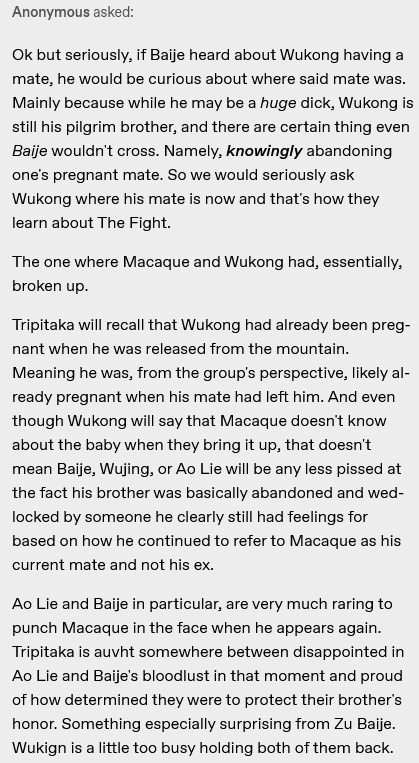
referencing this previous post about the Pilgrims reacting to the knowledge that au!Wukong is having a baby and has a missing mate.
Ao Lie is a real bro; he figured out Wukong was a having a kid based on his dragon/horse nose, and decides to support him 100% no matter his choice at the end of the day. The fact that he suspects its an asexually-produced Stone Egg that could kill his new buddy is something Ao Lie is keeping quiet about until Wukong himself is comfortable sharing it.
Ao Lie, after Bajie accuses him of having a crush on Wukong: "Ew no! He most certainly has a mate awaiting his return - I wouldn't dare dishonor a married demon!" Wukong, brightly playing along: "Yeah, piglet! Plus, no one will ever measure up to my Mihou!" Ao Lie, confused whinny: "Excuse me, what?" Wukong, tail curling into a heart: "The strongest, most clever monkey on Flower Fruit Mountain - my equal in all including on the battlefield. <3"
The rest of the gang are pleasantly surprised... and outraged to learn that their pregnant companion has a mate that up and left him while he was pregnant. Whomever this "Macaque" figure is, the Pilgrims gonna have a stern talk with him when they find him.

Except maybe the two former-celestials;
Bajie is just like: "Wait, did you just say this Macaque guy was your equal in battle!?" Wukong, wistful sigh: "Yeah..." Zhu Bajie & Sha Wujing: *share equally terrified looks*
Maybe they'll need to devise an attack strategy before confronting this guy head on. Ao Lie loudly states that he's gonna kick the guy if he sees him first.
Tripitaka meanwhile has to mentally wrap his head around the idea of two men marrying before he can process that *Sun Wukong* is married. The Confuscist / Buddhist attitudes at the time said "Girls have Karma Cooties"; so it was considered normal for men to "prefer other men's company" but it was still super-illegal. Being raised in a sheltered, likely all-male, monastery also adds in extra confusion for the monk. Not to mention his own asexuality.
Tripitaka: "Is it... acceptable for a man to love another man like one would a woman?" Zhu Bajie: "Only if they're into it." Tripitaka: "Wha...?"
Eventually he ends up asking the boddhisattvas and different gods for their opinions;
Tripitaka: "Is it normal amongst those in the Celestial Realm for men to... have thoughts of romance for other men?" Erlang: "Oh diyu, yeah! It's totally normal! We even have Tu'er Shen - he's the rabbit god of homosexual love!" Tripitaka, pleasantly surprised: "Oh! That's interesting - but is it accepted?" Erlang & the Plum Hill Lads: *share a footballer's huddle, whispering intensely* Erlang: "Ehhh... just don't bring it up around my uncle. He's kinda weird about it." Triptiaka, a little heartbroken: "Oh..."
Best advice comes from Guanyin herself ofc;
Guanyin: "I'm am composed of multiple energies, Tang Monk. Although I do not experience romantic feelings like say, Chang'e and Hou Yi, I know for a fact that the buddha does not judge those for whom they love - even if their fellow man do so." Tripitaka: *delighted smile!* Tripitaka, remembering why he asked: *fatherly instincts activate* "I'm going to kill that Liu'er Mihou for breaking my student's heart!"
In the Jttw Stone Egged au where Macaque lives, Tripitaka is the only one to get a solid punch in before Wukong calls the gang off.
Angst and canonical death tw under Read More;

Zhu Bajie ultimately starts out as a huge a-hole, and the Journey makes him a little less of a jerk. One huge change Wukong noticed in his bro's behavior was around the time... he lost Macaque.
Especially in the Slow Boiled au.
Bajie would walk up to Wukong like he did many time when he tried stealing his snacks or to poke fun at him... only to sit down next to the monkey watches the moon together. Both longing.
Zhu Bajie: "You know... I wasn't lying when I said I was cursed to suffer many heartbreaks... I know what it looks like from a mile away." Wukong: *says nothing, hiding face in his arms and knees* Zhu Bajie: "You really loved that guy, huh?" Wukong: *nods, face still hidden* Zhu Bajie, confidently: "...you'll see him again. Maybe not in this lifetime, but you will." Wukong, uncharacteristically quiet: "Thanks..." Zhu Bajie: "No problem."
The pig is noticeably easier on Wukong after that day. And maybe a little more appriciative of the time he had with Culian... he's experienced enough bad love-lifes to figure out how to make things work. Maybe after the Journey is over, he'll give her a call?
He does really hope his Eldest Brother and his mate reunite in the future... even if it means in the Diyu.
#stone egg talk#slow boiled stone egg au#jttw stone egged au#death tw#canonical character death tw#pregnancy tw#sun wukong#shadowpeach#six eared macaque#liu er mihou#lmk tripitaka#lmk zhu bajie#lmk sha wujing#lmk ao lie#lmk erlang#lmk guanyin#lmk#lego monkie kid#lmk aus#jttw#jttw aus#journey the west
159 notes
·
View notes
Note
It's interesting to note how much of southeast asia's history and culture were incredibly influenced by India's. The majority religion in all of them used to be Buddhism and hindu-buddhism, both of which originated in India. Then in maritime southeast Asia and in Champa those faiths were replaced by Islam, which was introduced there by Indian merchants and missionaries. All native scripts from southeast Asia were derrived from brahmic scripts from India. The architecure of most of southeast asia has great indian influence. The languages of Sanskrit and Pali played extremely important roles in southeast asian history. (This all with the exception of vietnam, which is a sinosphere country with culture, language and religion incredibly influenced by China)
I'm not an expert at all in India but what's really remarkable is that India is on itself a subcontinent (on itself a very apt term) with an immense cultural diversity that we in the *west* are often very unaware about. All countries on Earth are diverse, of course, but just the country of India has more people and languages than the entire European Union, that should be a clue of how it is. It is also the home of entire religions, philosophies and civilizations.
I think that for us in the West and West-adjacent places, India (and the whole of Southeast Asia) are a big blindspot; I've had to make an effort to learn about Hinduism and Buddhism and I found that they, as so much other things, are massively misrepresented in popular knowledge of them. (I recommend the youtube channel Let's Talk Religion if anyone wants an intro to these topics)
But I wouldn't go as far as to say that Southeast Asia was completely dominated by India (that is the subcontinent as a whole). Researching a bit for fun (well, actually for strategy videogames) I found that there are so many religions and beliefs in Southeast Asia that a blanket label of "Buddhist" or "Hindu" isn't enough.
21 notes
·
View notes
Text
The story of Japan’s Kakure Kirishitan (Japanese for hidden Christians) is one of remarkable resilience and ingenuity. Forced underground by persecution in the 17th century, these communities practiced their faith in secret for over 200 years. One fascinating aspect of their survival strategy was the clever use of Buddhist imagery, particularly statues of Kannon, the Buddhist Bodhisattva of Mercy, to represent the Virgin Mary and the Christ Child.
69 notes
·
View notes
Text
emperor!geto x imperial concubine!reader
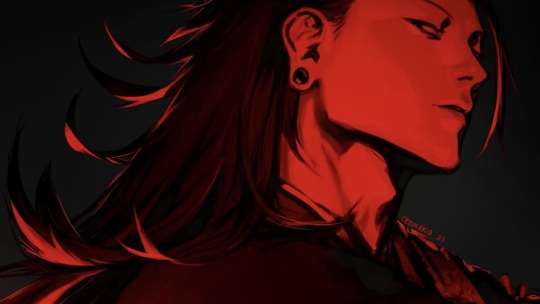
a/n: I’ve spent way too much time to research about chinese imperial concubines, playing with Royal Chaos during my highschool years and I had a boring shift at work. This is the result. Probably out of character as hell but hey, I wrote this for my enjoyment.
This is part 1 of a lil historical AU drabble series. I’m already finished with Sukuna, Gojo is in the works, and I got some ideas for Choso and Toji but don't think too much about it, ideas are just ideas.
I was so close to write reader as gender neutral but reader owns a type of traditional chinese headgear used exclusively by noblewomen so... yeah, reader is afab if you squint (very hard).
Likes and reblogs are appreciated, mwah <3
wc: 1011, I initally wanted a few headcannons but I got a full ass drabble
cw: suggestive, false accusations, implied murder, mentions of whipping, choking (not the kinky kind), yandere behavior
credits: renmakia for the gorgeous fanart and my dear @notveryrussian for proofreading and just putting up with my massive jjk brainrot every day, luv ya darling <33
MDNI, if you do, I'm gonna catch you like I'm gonna catch Gege.
He’s a monarch who considers his mind a weapon and information as a whetstone despite being born in relative peace. Spending his leisure time reading Sun Ce, the scripts of Confucian and Taoist scholars, sharing afternoon teas and long walks around the gardens with Buddhist priests and conversing about reaching enlightenment. As if he desperately wanted to understand how the world he was meant to rule works. His mandate of heaven brought prosperity, a flourishing economy, a strong connection between allied realms, a good education system that produced more scholars than in any other time before.
Competing for his attention is not an easy task. You almost gave up, bracing yourself for a long and uneventful life where you can only admire him from afar. You sit in the shade of a willow tree with a board of xiangqi, your playmate having left you not so long ago and you were trying to figure out which tactics and strategies they should’ve used to defeat you. You’re so lost in your thoughts you can’t notice him standing there, in the presence of his guards. You kowtow to him, excusing yourself for daring to bother him, pleading for his patience while you pack your things and leave. He likes that your manners are spot on, and he rewards you with a command to stay, to play with him, since xiangqi is a game between two people. And based on the positions of the pieces on the board you’re an experienced player.
Of course, he defeats you with ease, but he’s grateful you showed him everything you’ve got and didn’t let him win. He tells you that his victory lies in applying the teachings of Sun Ce to his playstyle. Your eyes light up and you beg him to elaborate further, maybe he can help you improve your tactics in the next game. He’s such a well-read man, so hungry for knowledge, so desperate to understand people. You’re sure he wants to figure out your thoughts too, what you think about the world, what values dominate your heart. And the secret to win him over is to shower him with all the details and even politely disagree with some of his beliefs and explain your point of view. That’s what gets him going, knowing your place in the hierarchy but not being afraid to stand your ground. Mindless obedience, at this point, bores him. That’s probably the reason why he slowly starts to favor you, your conversations refresh him, inside and outside of his bedchambers.
You may think that earning your place in his heart is a lengthy and hard process, but when he becomes sure that your infatuation comes from an honest place, he generously rewards your efforts. He showers you with gifts, each more thoughtful than the other. He sends you scripts from his personal library about topics that interest you, fulus he received from his priests to protect you and your chambers, phoenix crowns so elaborately adorned with pearls, sapphires, small dragons, and phoenixes made from solid gold. Gowns embroidered with clouds, cranes dancing around them, gifting you a small piece of the sky itself he descended from. He elevates your rank quickly so you can accompany him during events. Letting the whole court look at you, wrapped in everything he gave you, standing so close you can see him stealing glances at you from under the twelve tasseled crown. He rewards your family with money, grain, rice, political power. If he lifts you up, he does the same with everyone important to you.
But Geto’s court is highly competitive. It’s certainly not easy to be his favorite. You can literally smell the stench of jealousy eminating from the other consorts. Their gaze pierces your skin deeply when the eunuchs drag you around the Palace of Heavenly Grace with a brocade blanket hugging your naked figure. They must endure the sight every other night and they have no idea that the son of heaven is ready to serve you and do as you please behind closed doors and not the other way around, as tradition dictates.
Though he can comfort you, outside of his chambers you fear for your life. You needed a food taster now and never dared to walk the gardens without at least four guards in your proximity. You begin to doubt the trust between you and those you’ve befriended, because they can only blame you for his negligence towards them.
And then, the first accusation about you begins circulating around the palace. Some concubines claimed that you were guilty of witchcraft. So many of them are against you, with so much made-up proof you cannot do more than spend the night crying, believing that at dawn, guards will come for you and throw you into a well. You have no idea where Geto is or how you could beg him for protection.
The next day, strangely, a new set of officials deem you innocent. What boggles you even more is that he comes to your residence instead of having you delivered to him. Even his scent is not like it usually is, there’s something metallic, salty, and musky mixed in with the incense smoke.
That night he cradles you, shushing you, promising to keep you safe at all costs. Keeping it a secret how brutally he disposed of the rumor mongers, how he had some of his officials whipped bloody for not believing your testimony or about the thinly veiled threats that he’ll make anyone’s life a living nightmare if anything happened to you. Your heart skips a beat and simultaneously sinks deep in your chest when those of higher rank than you lower their head, trying their best to not look at you as they pass you by. With dark marks staining the skin below the neckline of their gowns, not even the empress consort being an exception.
It's not easy to be his favorite. It’ll never be easy.
But he’s a god, the son of heaven, and heaven will forgive him and so will you.
#jujutsu kaisen#jjk#jjk x reader#jujutsu kaisen x reader#geto suguru x reader#jjk drabbles#getou suguru x reader#jjk x y/n#meesa writes
333 notes
·
View notes
Text
In 1955, in Bangkok, Thailand, workers prepared to relocate a heavy, unremarkable plaster Buddha statue within the temple Wat Traimit. During the process, a crane cable snapped, causing the statue to drop abruptly onto the muddy ground. The fall created a significant crack in its plain plaster exterior. Concerned about possible damage, monks covered the statue overnight to protect it from a heavy rainfall that occurred serendipitously, almost as if to cleanse or baptize it. The next morning, a monk inspecting the crack noticed a glimmering light shining from within. Upon closer examination and careful chiseling, they discovered something extraordinary: beneath the plain exterior lay a solid golden Buddha statue of immense historical and monetary value, previously hidden for centuries.
Historically, the Buddha had been concealed by monks centuries earlier during threats of invasion by neighboring armies. Covering the golden Buddha in plaster and mud was an act of preservation, disguising its true nature to deter theft and protect its sanctity. Over generations, the knowledge of its hidden truth faded, and people came to believe that the plaster Buddha was ordinary, forgetting entirely the precious gold within.
This historical event offers a profound psychological metaphor. Each individual inherently possesses an inner “Buddhanature,” an innate purity and awakened presence, hidden beneath layers of psychological plaster—layers shaped by social conditioning, misperceptions, protective strategies, and a self-image formed to ensure acceptance and survival. These external layers represent the superficial self, the ego, and accumulated misidentifications that obscure the awareness of our true nature.
In Christianity, this parallels the teaching, “the kingdom of God is within you,” echoing the concept that our authentic essence—our real “Self,” as opposed to our constructed self-image—is fundamentally pure, whole, and luminous. Similarly, Buddhist philosophy emphasizes “pure, open awareness,” the boundless clarity and presence at the core of every individual’s being. The accidental drop of the statue symbolizes life’s events that challenge our conditioned identities, often perceived as damaging, but ultimately providing an opportunity to reveal our deeper truth thru awareness.
Thus, beneath the mud and plaster of our limited self-perceptions, we all are golden Buddha—pure, open awareness—waiting to be uncovered through insight, self-inquiry, and mindfulness, returning us to our authentic nature.
9 notes
·
View notes
Photo
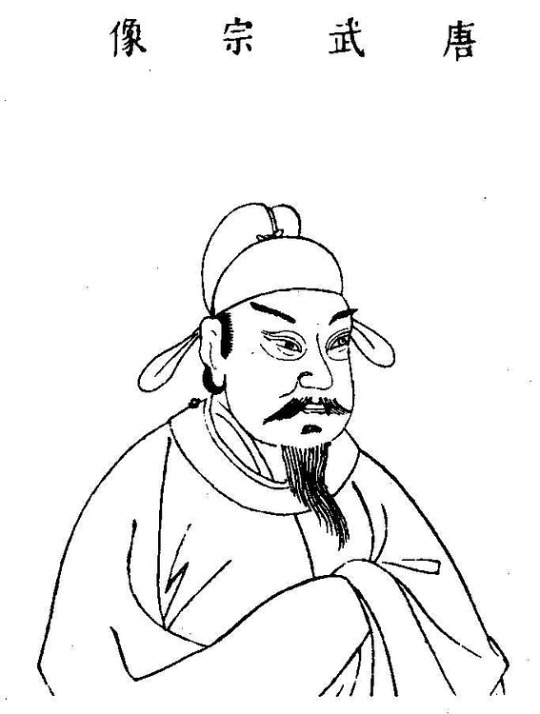
Emperor Wuzong of Tang
Wuzong of Tang (also Wu-Tsung, formerly Li Yan) reigned as emperor of China from 840 to 846 CE. He is best remembered today for his persecution of Buddhists, the worst such attack in all of China's history, and his early death by insanity from drug abuse. Wuzong, nevertheless, did manage to steer the Tang Dynasty clear of the excessive political in-fighting and eunuch dominance which had plagued the courts of his predecessors.
Political Achievements
Wuzong was born in 814 CE, the fifth son of Emperor Muzong (r. 820-824 CE). He was the younger brother of his predecessor, Emperor Wenzong (aka Wen-tsung, r. 827-840 CE) and held the title Prince of Ying before his succession. He gained the throne because Wenzong's own son had died in mysterious circumstances in 838 CE. Wuzong also had the full support of the court eunuchs, the powerful group who dominated Chinese politics. His character and style of rule is here summarised by the historian M. T. Dalby,
...the emperor was brash, quick-tempered and stubborn. But, unlike his elder brother Wen-tsung, he was also shrewd and decisive. Like a number of his predecessors, religion gripped him as much as politics. To the family weakness for alchemical experimentation in search of immortality, he added a genuine interest in Taoism.
(Twitchett, 663).
The emperor found another able ally in his chief minister Li Deyu (787-850 CE). Deyu had been briefly exiled in a previous reign and he would be exiled in a future one but Wuzong seemed to appreciate his talents. Together they were able to reduce the political factionalism which had long beset the Tang court and even to reduce, bit by bit, the influence of the eunuchs who had long abused their privileged position within the palace, controlling who had access to the emperor and profiting from it.
Deyu's strategy of government was to reduce the involvement of all chief ministers, who had been notoriously argumentative in discussions of policy under the previous emperor. Instead Deyu took all major decisions himself in consultation with the emperor and removed the debates and consequent factions which had traditionally been a part of Tang government. As he put it himself, government decisions should “issue forth from a single gate” (Twitchett, 661). Deyu did make some of his own loyal followers aides with junior positions but he also resisted the usual purge of the court which followed every new succession. Another feature of the new regime was the meticulous keeping of public records for all official communications, meetings and decisions.
Continue reading...
29 notes
·
View notes
Text
DEITY MASTERLIST (PART TWO)
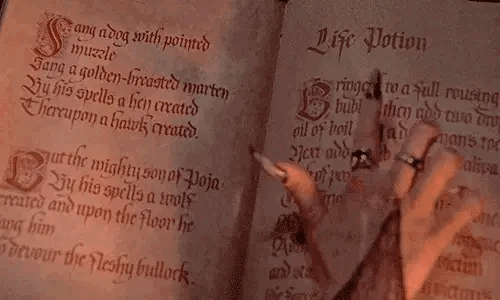
📿 Kuan Yin
Goddess of: mercy and compassion
Culture: Chinese/Buddhist
Symbols: vase, rosary, willow branch, fish basket, and pearls
Plants: lotus, willow, and bamboo
Animals: horse, peacock, dragon, and birds
Colours: white
Tarot: Judgment
Offerings: oranges, pomegranates, spices, oolong tea, incense, and love and compassion for both yourself and others
🌱 Lada
Goddess of: spring, beauty, love, and fertility
Culture: Slavic
Symbols: Lada Star, bells, and Spring Equinox
Plants: linden, dandelion, peony, and birch
Animals: lark, deer, ant, and eagle
Colours: red and white
Tarot: Page of Cups and The Lovers
Offerings: honey, music, mead, apples, sweets, lemon balm, cherries, and chestnuts
🌉 Lilith
Goddess of: love, demons, beauty, wisdom, life, rebirth, fertility, motherhood, inner-strength, illumination, mysteries, spiritual initiation, the night, and The Evening Star
Culture: Demonic
Symbols: sword, pentagram, scythe, moon, dragon, snake, crossroad, dark moon, and pentacle
Plants: apple, poisonous plants (belladonna, hemlock, and mugwort), sandalwood, rose, dandelion, red hibiscus, witch hazel, lilac, and patchouli
Animals: black cats, snakes, owls, dogs, spiders, bats, and goats
Colours: red, black, purple, blue, green, silver, and gold
Tarot: The Devil
Offerings: black candles, black stones, or black crystals, honey, champagne, seductive perfume, fancy jewelry, tea, exercise, having sex and/or masterbating, swords and daggers, pomegranates, dark chocolate, sex toys or other items related to sex and pleasure, dragon’s blood, flowers and herbs: lilies, red roses, sage, basil, mugwort, and rose, dancing, red wine, clay, depictions of owls, snakes, cats, dogs, bats, dragons, and spiders, mirrors, apples, red or black silk, and poetry.
🤘 Loki
God of: mischief and trickery
Culture: Norse
Symbols: serpents, wolves, ax, raven, masks, fire, Bjarken and Logr Runes, fishing nets, earthquakes, infinity snake and ouroboros, number 8, chaos star, runes that spell out his name: Laguz, Othala, Kenaz, Isa as well as the rune Hagalaz, and Helmet of Dread or the Helmet of Horror
Plants: mistletoe, birch, common Haircap moss (Loki’s Oats), bentgrass (Loki’s Grass), cinnamon, dandelion, beech, blackthorn, elder, elm, ivy, juniper, mullein, thistle, mint, holly, cedar, juniper, elder, clove, patchouli, tobacco, willow, and yew
Animals: salmon, crows, , ravens, falcon, vulture, flies, goats, flea, horses, wolves, foxes, and spiders
Colours: green, gold, black, violet, yellow, orange, and red
Tarot: The Fool, The Tower, The Devil, The Wheel of Fortune, Page of Cups, and Seven of Swords
Offerings: candles, especially black ones, incense, a musky or mysterious scent would be appropriate, red fruits or flowers, gems or metals, herbs, such as dill, ginger, and mugwort, art or poetry, toys, such as the ones you used to play with as a kid, acts of chaos, subversion, or mischief, flowers: daisies, roses, and lilies, crystals, hanging mistletoe at Yuletide, foods and drinks: sweet foods, alcohol, spicy rum, candy, mulled wine, chocolate with nuts or funny names, spongecake, coffee or other caffeinated beverages, honey, and pastries, knives and daggers, doing something you are scared of (safely), and cinnamon.
🌅 Lucifer
God of: illumination, light, darkness, change, rebirth, challenges, innovation, logic, truth, knowledge, wisdom, strategy, persuasion, revolution, luxury, pleasure, freedom, The Arts and The Morning Star (“Morning Star” is another name for the planet Venus)
Culture: Demonic, Pagan, and Greco-Roman
Symbols: Sigil of Lucifer, The Morning Star, violins and fiddles, dragons, wings, serpents, black goats, inverted pentagram, light, and the pentacle.
Plants: belladonna, mulberry, patchouli, myrrh, min, tobacco, marigold, lilies, hyacinth, rosemary, and black poppies, lavender, mint, blackberries, sage, apples, pomegranates, lilac, rose, black pepper, hyssop, gardenia, geranium, garlic, yarrow, and cypress.
Animals: black animals in general, snakes, spiders, ravens, wolves, dragons, eagles, crows, goats, bats, rats, moths, flies, peacocks, insects, and swans.
Colours: blue, red, black, gold, emerald green, and silver.
Tarot: The Devil.
Offerings: candles or torches, sweet treats like dark chocolate or pastries, red, black, or dead roses, incense like sage or cinnamon, red wine, whiskey, especially Jack Daniels, champagne, pomegranate/pomegranate juice, black tea, especially earl grey, cooked goat meat, venison, apples, honey, good quality cigars, tobacco, daggers and swords, silver rings, emeralds and emerald jewelry, goat horns, black feathers, seductive colognes, crow skulls, bone dice, devotional poetry and artwork, and classical music, especially violin.
🦁 Lugh
God of: the Sun, The Arts, storms, The Harvest, oaths, Kings, justice, craftsmanship, smithcraft, light, and warriors
Culture: Celtic
Symbols: spear, harp, and slingshot
Plants: apple, oak, hazel, holly, marigold, goldenrod, sunflower, carnation, rose, gorse, bay, basil, allspice, rosemary, and cinnamon
Animals: lion, horse, raven, stag, crow, hound, and lynx
Colours: brown, gold, yellow, green, red, and blue
Tarot: The Emperor, Justice, Strength, The Sun, and Suit of Wands
Offerings: wine, mead, apple cider, corn, bread, apples, berries, potatoes, beer, harvested fruits and vegetables, corn dolls, cloves, gorse flowers, and handmade crafts
🪐 Ma'at
Goddess of: truth, justice, cosmic order, harmony, wisdom, morality, and balance
Culture: Egyptian
Symbols: scales, ostrich feathers, Ankh
Plants: papyrus
Animals: vulture and ostrich
Colours: purple and black
Tarot: Justice, Temperance, and Judgment
Offerings: no drugs and alcohol, cold water, tea with milk, dates, plums, fish, chicken, olive oil, vinegar, hummus, barley biscuits, reeds, gold jewelry, and white linen.
🦭 Manannan Mac Lir
God of: the sea, weather, navigation, and Guardian of the Otherworld
Culture: Celtic
Symbols: cups, cloak, a silver branch with three golden apples on it, and mermaids
Plants: alder, apple, hazel, blackberry, bramble, reed, meadow grass, yellow flowers, and seaweed
Animals: horse, pig, cow, seal, crane, swan, boar, dog, dolphin, sea horse, and whale
Colours: blue, silver, and gold
Tarot: The Chariot
Offerings: yellow flowers, sea water, bread, ale, and mead.
🌒 Máni
God of: personification of the Moon and protector of children and the mentally ill
Culture: Norse
Symbols: silver, the Moon, and astrology
Plants: jasmine, carnations, night-blooming flowers, and aromatic flowers
Animals: horse, rabbit, and wolf
Colours: blue, silver, black, lavender, and white
Tarot: The Moon
Offerings: peppermint-flavored sweets, peppermint Tea, angel food cake, relaxing tea, and salt
♟️ Marduk
God of: justice, compassion, war, healing, magic, storms, and agriculture
Culture: Mesopotamian
Symbols: lightning, war chariot, and weapons
Plants: grain
Animals: horse, dog, dragon, and eagle
Colours: gold
Tarot: The Emperor
Offerings: beer, ale, daggers, golden jewelry, bread and grains, coffee, artwork and poetry, feathers, meat, and fruit.
🕯️ Medea
Goddess of: Witch and Priestess of Hecate, invoke for justice, vengeance, and protection
Culture: Greek
Symbols: poisons, cauldrons, and golden fleece
Plants: juniper, olive, and wolf’s bane
Animals: dragon and snake
Colours: gold and white
Tarot: The Magician
Offerings: wine, frankincense, milk, honey, poisons, artifacts of Witchcraft, flowers, and snake and dragon imagery.
🤰 Mokosh
Goddess of: spinning, weaving, fiber arts, moisture, shearing, protection, childbirth, spell casting, fate, fertility, life, death, and rebirth
Culture: Slavic
Symbols: mokosh tones, rain, solar and earthly symbols
Plants: local seasonal plants
Animals: sheep, cat, and horse
Colours: gold, white, and red
Tarot: The Empress
Offerings: personal needlework, wool and flax, grains and bread, salt, oilseeds, dairy, berries, eggs (especially Pisanki), porridge, milk, honey, herbs, fruits, vegetables, a lock of your own hair, and locally sourced seasonal crops.
☃️ Morana
Goddess of: winter, death, and rebirth
Culture: Slavic
Symbols: poppets (spell dolls) and water
Plants: evergreen, berries, grass, rosemary, cypress, wormwood, mandrake, and elderberry
Animals: snake
Colours: white, red, black, and grey
Tarot: Death
Offerings: tea, water, rocks, bones alcoholic beverages, bread, oats, seeds, fruit, and homemade foods and baked goods.
🪄 Morgan le Fay
Goddess of: Witchcraft
Culture: Welsh/Arthurian
Symbols: artifacts of Witchcraft
Plants: honeysuckle, henbane, reed, aspen, oak, and willow
Animals: crow, crane, raven, black dog, horse, cow, and wolf
Colours: red, black, and lavender
Tarot: The Moon and The Magician
Offerings: red ribbons, crow and raven feathers, whiskey, rum.
✊ Nemesis
Goddess of: retribution, fairness, and Punisher of Hubris
Culture: Greek
Symbols: sword, lash, dagger, scales, and apple branch
Plants: Apple Tree, Thistle
Animals: griffin and goose
Colours: red, black, silver, gold
Tarot: Justice
Offerings: wine, olive oil, water, fruit, honey, milk, feathers, apple seeds, apple blossoms, bones, scales, chains, daffodils and narcissus flowers.
😷 Nergal
God of: war, death, plagues and disease
Culture: Mesopotamian
Symbols: lion-headed Mace and sword
Plants: thistle, grapefruit, and pomegranate
Animals: lion, bull, and bat
Colours: red, black, silver, and gold
Tarot: The Tower, The Devil, and Death
Offerings: animal bones, thorn branches, bitter lemonade, absinthe, and pomegranate juice.
🏋️ Nike
Goddess of: victory
Culture: Greek
Symbols: balm branch, wings, a wreath, sash, and lyre
Plants: palm tree and laurel tree
Animals: horse
Colours: silver, gold, and blue
Tarot: Wheel of Fortune, Justice, and Strength
Offerings: feathers, trophies, medals, palm branches or leaves, and athletic equipment.
🪴 Ninhursag
Goddess of: the Earth, motherhood, childbirth, fertility, nourishment, agriculture, and vegetation
Culture: Mesopotamian
Symbols: omega symbol, bow, and mace
Plants: all grown vegetation
Animals: Cow, Lion, Fish, Serpent
Colours: green, gold, white, and silver
Tarot: The World, The Empress, Suit of Pentacles, and Queen of Pentacles
Offerings: wine, beer, fresh water, cooked fish, eggs, vegetarian foods, bread, honey, butter, myrrh, and all flowers.
🐚 Njörð
God of: the sea, the wind, abundance, and wealth
Culture: Norse
Symbols: ships
Plants: avens, ferns, oak, oak moss, polypody, verbena, rosemary, reeds, and bay
Animals: fish and aquatic creatures
Colours: blue
Tarot: King of Cups
Offerings: fish, seafood, pork, chocolate coins, sea salt chocolate, dark beer, gin, golden items, beads, shells, tobacco, and fishing gear.
🌃 Nut
Goddess of: night
Culture: Egyptian
Symbols: Ankh and water pot
Plants: sycamore and fig
Animals: boar, cow, vulture, and hippo
Colours: dark blue
Tarot: The Star
Offerings: milk, cool water, star-shaped foods, blue goldstone, and blue flowers
🌌 Nyx
Goddess of: the night
Culture: Greek
Symbols: crescent moon, mist, darkness, and stars
Plants: poppies, night blooming lilies, moon flowers, and gladiolus
Animals: owl, crow, and bat
Colours: dark blue and black
Tarot: The Star
Offerings: milk, black coffee or tea, dark chocolate, silver jewelry, dragon fruit, dew gathered before the sun rises, wine, dark beer or liquors, and starry and celestial items.
📖 Odin
God of: wisdom, healing, death, royalty, the gallows, frenzy, knowledge, war, battle, victory, sorcery, poetry, and Runic alphabet
Culture: Norse
Symbols: valknut, right-legged horse (Sleipnir), wolves, ravens, spear (Gungnir), and the Othala Rune
Plants: mugwort, plantain, wormwood, chamomile, pine, apple, fennel, juniper, elfwort, and wotan’s herb
Animals: wolf, raven, snake, bear, and horse
Colours: grey, deep blue, and black
Tarot: The Hermit, The Magician, and The Hanged Man
Offerings: red wine, mead, beer, ale, quality alcohol, whiskey, smoked salmon, red meat, beef, leeks, asparagus, garlic, and honey
💦 Ọṣun / Oshun
Goddess of: water, purity, fertility, love, sensuality, freshwater, wealth, diplomacy, and The Osun River
Culture: Yoruba
Symbols: seashells, and amber beads
Plants: cinnamon, sunflowers, oranges, yellow squash, marigold, pumpkin, rosemary, and lantana
Animals: peacock, vulture, catfish, river fish in general, cricket, leopard, and crocodile
Colours: white, gold, amber, yellow, and coral
Tarot: The Empress
Offerings: honey (taste before you offer it) , bowl of water, flowers, seashells, beauty items, chamomile tea, cooked shrimp and spinach, yellow and orange fruits and vegetables, sliced orange drizzled with tasted cinnamon honey.
⚰️ Osiris
God of: the Underworld, death, resurrection, fertility, and agriculture
Culture: Egyptian
Symbols: crook and flail, atef crown, ostrich feathers, mummy gauze, and djed
Plants: willow, tamarisk tree, and many types of houseplants
Animals: bull, ostrich, and dog
Colours: black and green
Tarot: The Emperor, The Hierophant, The Lovers, The Hanged Man, Death, and Judgment
Offerings: green and black crystals, bread, beer, beef, bird meat, and nice clothing
🌫️ Ọya
Goddess of: weather, death and rebirth, a psychopomp, and patron of the Niger River
Culture: Yoruba
Symbols: lightning, sword, machete, and fly-whisk
Plants: akoko tree, camwood, camphor, cypress, marigold, and mimosa
Animals: water buffalo, antelope, sheep, and locust
Colours: purple, burgundy, and the rainbow
Tarot: Strength, The High Priestess, and The Empress
Offerings: starfruit, black-eyed peas, plums, purple grapes, mine eggplants is a traditional offering (or one eggplant sliced into nine pieces), and red wine
🐐 Pan
God of: the wild, shepherds, flocks, rustic music, fertility, hunters, mountains, forests, and meadows
Culture: Greek
Symbols: panpipes
Plants: Coriscan Pine, Water-reed, Pine Trees
Animals: goat
Colours: green, brown, and purple
Tarot: The Fool, The Lovers, The Devil, King of Pentacles, and Page of Pentacles
Offerings: pine cones, pine branches, animal bones, musical instruments (especially Woodwinds), milk, honey, and lamb or goat meat
🌋 Pele
Goddess of: volcanoes, fire, Land lightening
Culture: Hawaiian
Symbols: volcano, fire, and lava
Plants: ohi’a lehua, lehua lower, strawberry, sugar cane, tobacco, coconut, and pineapple
Animals: Hawaiian honeycreeper, sea turtle, fish, and white dogs
Colours: red, orange, yellow, green, and black
Tarot: The Tower and Suit of Wands
Offerings: fruits, flowers, forest plants, berries, vegetables, gin, and cigars
⚱️ Persephone
Goddess of: the Underworld and spring
Culture: Greek
Symbols: pomegranate, grain, torch, and flowers
Plants: asphodel wheat, willow, narcissus, lily, ivy, lily of the valley, daisy, and lavender
Animals: deer, bat, black ram, parrot, and monkey
Colours: green, black, light blue, purple, magenta, indigo, and yellow
Tarot: The Hermit, The Hanged Man, Death, Judgment, and Knight of Pentacles
Offerings: pomegranates/pomegranate juice, honey, floral tea, breads and sweets, flower crowns or arrangements, dark chocolate, flowers, crushed mint, animal bones, jewelry, and/or your artwork
🌊 Poseidon
God of: the sea, water, horses, and earthquakes
Culture: Greek
Symbols: trident
Plants: pine tree and wild celery
Animals: fish, dolphin, horse, and bull
Colours: blue, teal, green, and silver
Tarot: King of Cups and Suit of Cups
Offerings: ocean water, honey, olive oil, seaweed, white wine poured into water, wild celery, homemade seafood, seashells, sea salt, coral, mint, and sand
☀️ Ra
God of: creator god, and the sun
Culture: Egyptian
Symbols: sun disk, ankh, , and sceptre
Plants: citrus fruits, marigold, sunflower, papyrus, daisy, and lotus
Animals: falcon, lion, and eagle
Colours: yellow, gold, orange, red, and white
Tarot: The Emperor and The Sun
Offerings: fruit juice, citrus fruits, honey, water, beer, wine, bread, barley, figs, dates, chocolate, chicken or duck, beef, and frankincense.
🚢 Rán
Goddess of: the sea
Culture: Norse
Symbols: Fishing Nets, Stormy Seas
Plants: beech, buckthorn, elder, elm, ivy, juniper, willow, and yew
Animals: aquatic Animals
Colours: black an sea-green
Tarot: Queen of Cups
Offerings: clean up the ocean, seashells, fishing with a net, seafood, gold, coins, sea rocks, flowers, sand, seawater, bread? cakes, and mead
🐎 Rhiannon
Goddess of: the moon, horses, songbirds, wind, gates, and horseshoes
Culture: Welsh
Symbols: the moon, horseshoes, waning moon phases, gates, the winds, and the number 7
Plants: cedar, pine, narcissus, daffodils, pansies, rosemary, sage, bay, lavender, and all white flowers
Animals: horse, frog, dog, songbird, dragon, badger, and hummingbird
Colours: green, silver, black, white, grey, red, maroon, and brown
Tarot: The Moon
Offerings: soft-sounding music, a white candle with the number 7 carved into it, white flowers, apples, willow, ivy, evergreens, caring for horses, caring for dogs, and studying liminal spaces and astral work
💀 Santa Muerte
Goddess of: healing, protection, financial wellbeing, and the afterlife
Culture: Mexican
Symbols: scythe, globe, scales of justice, and oil lamp
Plants: fresh flowers, apples, and marigolds
Animals: owl, dogs, cats, dove, crows, and snakes
Colours: red, white, black, blue, and green
Tarot: Death
Offerings: cash, cigars, apples, tequila, cannabis, fresh water, candles, candy, fruit, roses, and bread
🌙 Selene
Goddess of: the Moon
Culture: Roman
Symbols: crescent, torch, chariot, billowing cloak, bull, stars, moon, horse, lunar cycle, torch, and bull horns
Plants: willow, moonflower, lavender, wisteria, oak, lilac, birch, rose, dandelion, and jasmine
Animals: horse, bull, mule, and ox
Incense: frankincense, rosemary, guaiac, orris root, and tonka bean
Colours: silver, blue, white, and grey
Tarot: The Moon, The Star, and Temperance
Offerings: white foods, moon water, dew, glitter/shiny objects, olive oil, flowers, fruit, moon-shaped things, water, honey, nephalia (wineless libation), milk, statues of horses, cakes, and crystals (moonstone, quartz, selenite, and pearl)
🦁 Sekhmet
Goddess of: war, destruction, healing, divine wrath, fire, and the sun
Culture: Egyptian
Symbols: the sun, scimitar, ankh, the desert, and pomegranates
Plants: carnation, rose, cloves, cinnamon, juniper, and orange blossoms
Animals: lion and cobra
Colours: red, gold, yellow, and white
Tarot: Strength, The Tower, and The Sun
Offerings: red wine, rum, beer, meats, bones, tobacco, wild cat skulls, weapons like daggers and swords, pomegranates, spicy foods, gold jewelry, red flowers, milk, blackberries, raspberries, mushrooms, and bread
💣 Set
God of: the sky, storms, the desert, disorder, war, foreigners, and a trickster God
Culture: Egyptian
Symbols: was sceptre and ankh
Plants: lettuce
Animals: hippopotamus, crocodile, scorpion, snapping turtle, wild pig, and donkey
Colours: red
Tarot: The Chariot, Death, and The Devil
Offerings: beer, whiskey, red wine, spicy foods, red meats, lettuce, shellfish, maces and daggers, bird eggs, cherries, dark chocolate, and shiny things
🪞 Sif
Goddess of: grain and fertility
Culture: Norse
Symbols: golden hair, loom, and mirror
Plants: birch, chamomile, fir, hawthorn, mugwort, rose, and willow
Animals: songbirds
Colours: gold and green
Tarot: Suit of Pentacles and Queen of Pentacles
Offerings: beer, honey, mead, grain, and bread
🎿 Skaði
Goddess of: winter, wilderness, mountains, bowhunting, and skiing
Culture: Norse
Symbols: skis, bow and arrows, snow, mountains, frost, and snowshoes
Plants: beech, blackthorn, elder, elm, ivy, juniper, mullein, and willow
Animals: wolf
Colours: white and brown
Tarot: The Hermit and Temperance
Offerings: vodka, traditional Scandinavian foods, meat from hunted animals (rabbit, deer, etc.), animal pelts, animal bones, and snow Water
🌞 Sól / Sunna
Goddess of: the Sun
Culture: Norse
Symbols: the Sun and gold
Plants: chamomile, cinnamon, corn, daisy, marigold, citrus fruits, rosemary, sunflower, and wheat
Animals: horse
Colours: gold, red, yellow, orange, white, and green
Tarot: The Sun
Offerings: mead, honey, bread, cider, and fruit juice
🪦 Thanatos
God of: personification of death
Culture: Greek
Symbols: sword, inverted torch, theta, wreath, wings
Plants: poppy and cypress
Animals: butterfly
Colours: black, silver, white, and purple
Tarot: Death
Offerings: (traditional liquid offerings are poured into the ground and food is buried), red wine, olive oil, water, honey, poppy seeds, black tea, dark chocolate, feathers, animal bones, snake skin, and graveyard dirt (collected respectfully)
🍃 The Dagda
God of: fertility, agriculture, strength, magic, druidry, wisdom, father-figure, King and Druid
Culture: Celtic
Symbols: club, cauldron, and harp
Plants: grains and oats
Animals: pig and bull
Colours: black, silver, white, and purple
Tarot: Strength, Wheel of Fortune, The World, King of Pentacles, King of Wands
Offerings: Porridge, Mead, Milk, Honey, Pork, Beef, Mutton, Music, and Laughter
Offerings: honey, olive oil, sweets, flowers, herbs, plants, bread, wheat, fruit, sunflower oil, beer, mead, spring water, vegetables, grains, and baked goods
🔮 The Morrigan
Goddess of: magic, battle, life and death, sovereignty, fresh water, prophecy, and fate
Culture: Celtic
Symbols: cloak, spear, chariot, sword, and shield
Plants: willow, aspen, rowan, snapdragon, hawthorn, yew, belladonna, mugwort, and nightshade (do not consume, handle with care!)
Animals: crow, raven, horse, eel, serpent, and wolf
Colours: red, black, white, blue, and green
Tarot: Suit of Swords, Queen of Swords, Justice, and Death
Offerings: red meat, red wine poured into the ground, apples, mead, milk, whiskey, storm water, crow feathers, knives and daggers, and artwork
🌩️ Thor
God of: thunder, lightning, strength, protection, fertility, masculinity, and protector of humanity
Culture: Norse
Symbols: Mjölnir
Plants: oak, garlic, onion, gorse, thistle, hawthorn, leeks, houseleek, mountain ash, hazel, pine, acorns, and oak moss
Animals: goat and bull
Colours: red, white, gold, and blue
Tarot: Strength and The Chariot
Offerings: hearty foods with lots of meat or onions, mead, beer, flattery, oak, whiskey, coffee, and honey
✒️ Thoth
God of: knowledge, wisdom, writing, mathematics, science, magic, truth, integrity, time, and the moon
Culture: Egyptian
Symbols: scales, papyrus scroll, stylus, crescent moon, and a pen
Plants: papyrus and sweet flag
Animals: ibis and baboon
Colours: white, blue, and teal
Tarot: The Magician, The Hierophant, The Star, and The Moon
Offerings: black tea, water, honey, blackberries, apricots, salmon, tuna, oranges (and orange-flavoured things), walnuts, cashews, quills, fountain pens, leather-bound books and journals, books you think he’d enjoy, silver, poetry, dark chocolate, whiskey, gin, mead, mint tea, and moon water
🗡️ Tyr
God of: war, lawgiver, justice, oaths
Culture: Norse
Symbols: weapons like arrows and spears
Plants: flowering spurge, holly, wolfsbane, and monkshood
Animals: wolf, bear, and eagle
Colours: red, silver, grey, and gold
Tarot: King of Swords
Offerings: wine, strong beer, salt, honey, bread, grains, beef, pork, and potatoes
🐄 Veles
God of: the Underworld, Earth, water, music, magic, trickery, cattle, and wealth
Culture: Slavic
Symbols: the symbol of Veles
Plants: willow
Animals: cow, bear, snake, wolf, dragon, and owl
Colours: gold, yellow, and red
Tarot: The Magician, The Hierophant, The Star, and The Moon
Offerings: cooked corn, bread, herbs (especially basil), wooden flutes and string instruments, black wool or fur, things carved from wood, coins, chicken, mistletoe, and music,
🌧️ Zeus
God of: King of the Gods, the sky, weather, law, order, justice, hospitality
Culture: Greek
Symbols: lightning bolt, cloud, sceptre, throne, and aegis
Plants: oak, olive, wild celery, artichoke, white poplar, and linden tree
Animals: eagle, bull, cuckoos, and swan
Colours: gold, yellow, blue, white, purple, and silver
Tarot: The Emperor, Justice, Wheel of Fortune, King of Swords, and The Fool
Offerings: wine, olive oil, water, honey, milk, red meat, bread and cakes, rainwater, golden objects, crowns, scales, eagle feathers, oak branches and leaves, beef or mutton, whiskey, and cinnamon.
#fyp#fypシ#fypシ゚viral#fypage#fyppage#tumblr fyp#satanism#satanist#deity#deity work#deity worship#occult#information#long post#gods#goddesses
50 notes
·
View notes
Text
Ch 59: Yum cha, fire and literal bubble tea

This chapter was just all-round beautiful. Atmospheric, poetic, visually vivid and full of music - although sometimes also uncomfortably realistic (unnaturally hot weather; mountain fires).
The red mountain made me think of landscapes I’ve seen. The idea of drums and bugles saving people from the sound of the sizzling sun sinking into the sea made me think of the din of musical instruments at Chinese New Year. The dragons in the streams and the paulownia trees were simply beautiful.
And the music! There is so much music. Yu’s footnotes say that three of the poems are set to pre-existing Chinese tunes. I tried to dig them up. They’re at the bottom of this post, for anyone interested.
Well, let’s begin. As we know, the travellers come upon a strangely sweltering part of the landscape. Bajie thinks they must be at the Edge of Heaven, but Wukong points out they can’t possibly have travelled that far. They approach the house of a local man, introduced to us through the ‘Not Quite’ poem.
I loved this poem. It reminded me a little of the Phantom Tollbooth or of Lewis Carroll. (Of course, that may well be because I don’t know much, if any, non-western poetry or literature with which to compare it. Do let me know if you know any Tollbooth-esque literature or poetry from other cultures.)
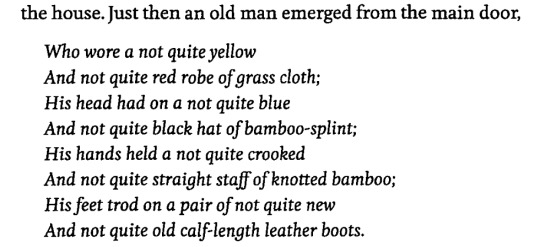
He tells them they’re at the foot of the Mountain of Flames.
I didn’t realise the flaming mountains were a real land feature in China - minus the pyrotechnics. Apparently travellers along the Silk Road avoided them. The soil temperature has been estimated at 66.8°C (152.2°F). (Thanks Wikipedia.)

Tripitaka is overwhelmed at the mere thought of the heat. He turns pale and falls silent - right back to his old ways:

Wukong, being the ADHD kid that he is, gets distracted by a vendor with a cart, and goes to buy rice pudding with a hair-turned-copper-coin.
I don’t know which kind of rice pudding this means, but it sounds delicious. Maybe this?

Or this?

But really I’m just thinking of this - which has nothing to do with rice or pudding, but everything to do with me getting excited when a Chinese food cart rolls around:

Wukong calls bullshit on the place being hot all year round. He figures if they can make rice flour for rice pudding, there have to be both hot and cool seasons.
And so they find out about Immortal/Princess Iron Fan, whose fan can extinguish the fires and even bring rain.
Cut to the woodcutter on Jade Cloud Mountain, who has a real chip on his shoulder about calling her ‘immortal’:

The 'Raksasi' thing may or may not be a jerk move, because apparently it just means ‘female demon’:

Wukong gets nervous about having to confront another angry relative of Red Boy, and the woodcutter schools him on how he should never be nervous as a Buddhist:

Even when Wukong explains his bind, the woodcutter stands by it:

I somehow love the total lack of strategy here. “Okay. You have every reason to think that this demon will refuse to give you what you want. Just disregard that entirely, and go in there confidently.”
Wukong finds Iron Fan, gets his ass kicked by her, and takes back some of the condescending thoughts he’d had about her as a woman fighter. We go from this:
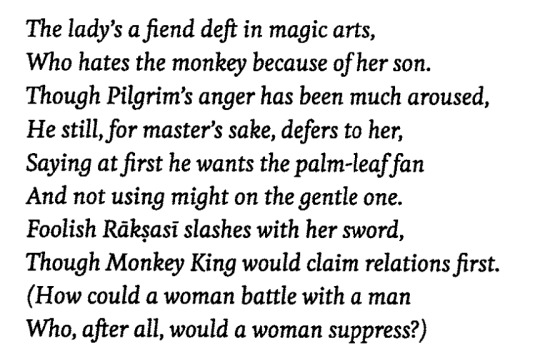
To this:

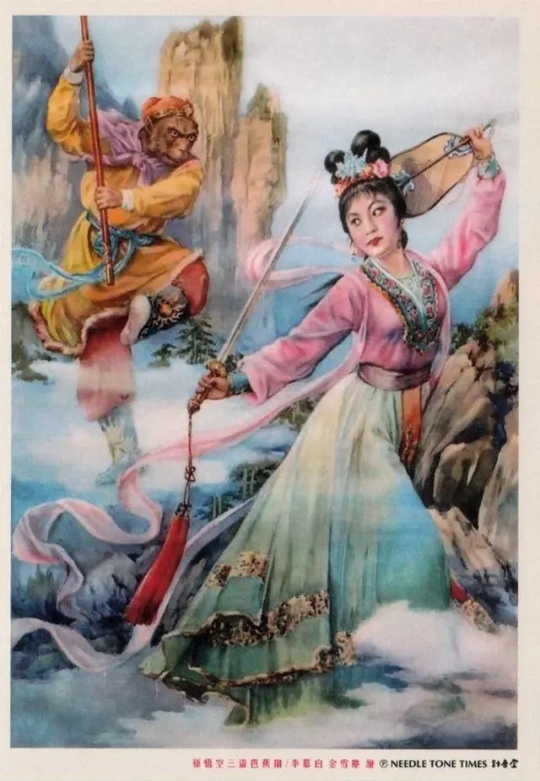
He’s bailed out by Bodhisattva Lingji, who conveniently has a Wind-Arresting Elixir. Wukong returns to unwarranted pride in his manhood in no time:

I mean, the only reason he can withstand the wind is that a woman was nice and gave him an elixir. So I'm not sure what it has to do with him being a man.
He sneaks into Iron Fan’s stomach via her tea:


In the ultimate Trojan Horse move, he prods her insides til it hurts. I must not have been the only one thinking of yum cha when the rice pudding came up, because the dim sum theme continues:
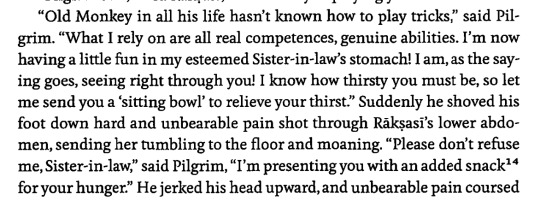


Iron-Fan puts on a good pretence of panicking and surrendering, but keeps her cool. She gives Wukong a fake iron fan. He doesn’t realise until he’s dragged the whole of Team Tripitaka up the Mountain of Flames and made the fire worse.
Tripitaka cries.

Ah, dear Tripitaka. He wants those scriptures. He wants them SO MUCH. And if he can’t get them, his heart is going to break.
Meanwhile, Bajie is just laughing his ass off because Wukong lost all the hair from his thighs in the fire.
The guys are at a bit of a loss. The only way to the west is to pass the Mountain of Fire, but nobody really knows what to do next. Clearly Wukong is no longer feeling so confident about kicking Iron Fan’s ass, cos he’s not even talking about trying a third time.
While they’re kicking around, they’re approached by a mysterious man, who turns out to be the spirit of the Mountain of Flames. He tips them off about what to do next.
And that’s it for this week. I’m excited for the next chapter, because I came across some ceramic art online that gave me some possible hints about next week. I’ll refrain from posting it, but we’ll see next week.

Music
As promised! The music for the three poems.
#1 To the tune of the Wind in the Pines
《風入松歌》 Feng Ru Song Ge


Music: https://www.youtube.com/watch?v=KOr1-ZeVGvM
About the music: https://silkqin.com/02qnpu/10tgyy/tg28frsg.htm
#2 To the tune of Barbarian Bodhisattvas


Probably this music? https://www.youtube.com/watch?v=d1jmF5zg9yI
#3 To the tune of Moon Over West River
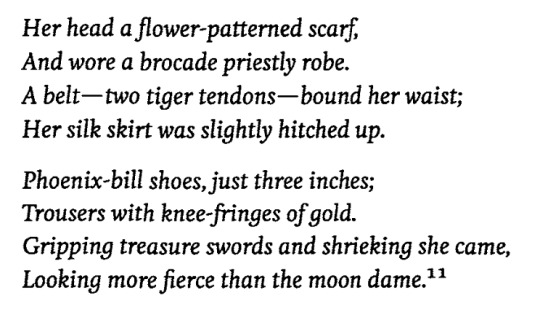

Music: https://www.youtube.com/watch?v=hGMkxd8RW5o
@journeythroughjourneytothewest
—
Image credits: The usual spiel. The images above are either AI, or random pictures from the web, or a Frankenstein of both; some modified, some not. They are not original. The pre-existing images should turn up with reverse googling or have links embedded, but feel free to ask and I’ll dig up sources.
#journey to the west#jttw#jtjttw submission#jttw reading group#jttw book club#tang sanzang#tripitaka#guanyin#sun wukong
11 notes
·
View notes